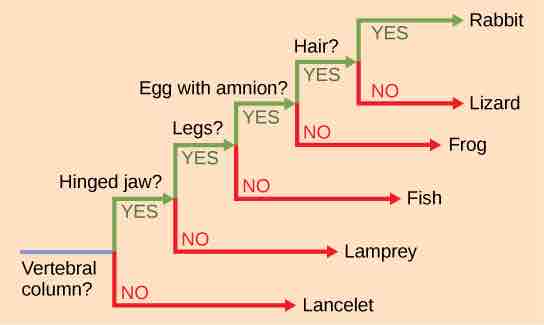Limitations of Phylogenetic Trees
It may be easy to assume that more closely-related organisms look more alike; while this is often the case, it is not always true. If two closely-related lineages evolved under significantly varied surroundings or after the evolution of a major new adaptation, it is possible for the two groups to appear more different than other groups that are not as closely related. For example, the phylogenetic tree shows that lizards and rabbits both have amniotic eggs, whereas frogs do not; yet lizards and frogs appear more similar than lizards and rabbits.

Limitations of phylogenetic trees
This ladder-like phylogenetic tree of vertebrates is rooted by an organism that lacked a vertebral column. At each branch point, organisms with different characters are placed in different groups based on the characteristics they share.
Another aspect of phylogenetic trees is that, unless otherwise indicated, the branches do not account for length of time, only the evolutionary order. In other words, the length of a branch does not typically mean more time passed; nor does a short branch mean less time passed, unless specified on the diagram. A tree may not indicate how much time passed between the evolution of amniotic eggs and hair. What the tree does show is the order in which things took place. For example, the tree in the diagram shows that the oldest trait is the vertebral column, followed by hinged jaws, and so forth. Remember, any phylogenetic tree is a part of the greater whole and, as with a real tree, it does not grow in only one direction after a new branch develops. So, simply because a vertebral column evolved does not mean that invertebrate evolution ceased. It only means that a new branch formed. Also, groups that are not closely related, but evolve under similar conditions, may appear more phenotypically similar to each other than to a close relative.